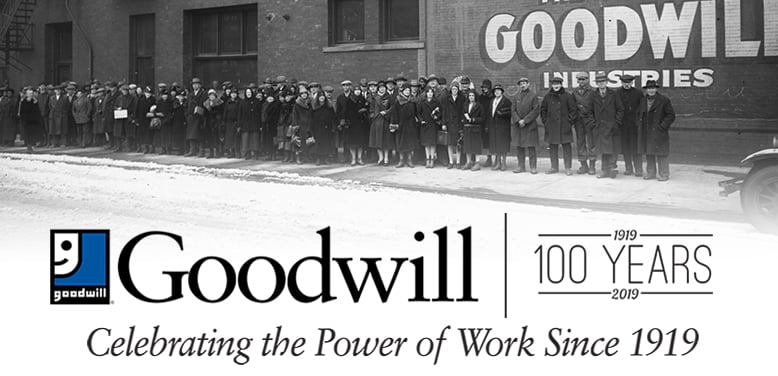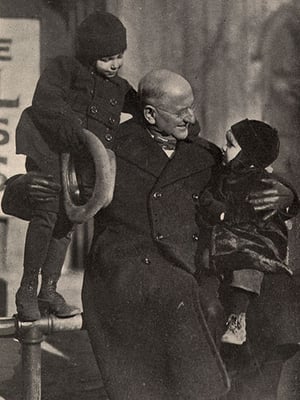Put your financial donation to work in your community.


 Goodwill Industries began in Boston at the turn of the 19th century as an idea by the Rev. Edgar J. Helms. The idea was simple, fight poverty not with charity, but with trade skills – and provide a chance for the poor and the unemployed to do productive work. In the 1890s, there were no government programs to aid those in need. Determined to provide a hand up, not a hand out, Helms put a burlap bag over his shoulder and went door-to-door, appealing to well-to-do people of Boston to contribute shoes, clothing, furniture, anything. Poor men and women were put to work restoring collected goods while learning trades and sharpening skills at the same time. Income from the resale of the goods paid their wages and eventually an industrial school developed.
Goodwill Industries began in Boston at the turn of the 19th century as an idea by the Rev. Edgar J. Helms. The idea was simple, fight poverty not with charity, but with trade skills – and provide a chance for the poor and the unemployed to do productive work. In the 1890s, there were no government programs to aid those in need. Determined to provide a hand up, not a hand out, Helms put a burlap bag over his shoulder and went door-to-door, appealing to well-to-do people of Boston to contribute shoes, clothing, furniture, anything. Poor men and women were put to work restoring collected goods while learning trades and sharpening skills at the same time. Income from the resale of the goods paid their wages and eventually an industrial school developed.
With Helms as the driving force, Goodwill Industries spread throughout the United States.
In the last 100 years, our services have changed to respond to the needs of the times. We began by helping people with disabilities and disadvantages repair donated items. We helped connect our neighbors with basic services during the Great Depression and were proud to provide training and jobs to wounded soldiers coming back from World War II. We trained people on computers when technology became part of the American workforce, and during recessions we have been instrumental in connecting people to jobs.
Although our services have changed, our belief in the Power of Work has remained the same.
Goodwill Industries of Southeastern Wisconsin and Metropolitan Chicago is an organization that has experienced unprecedented growth, and is the largest Goodwill organization in the world. Our growth continues especially in the greater Chicagoland area.
Late 1910s – 1920s
Goodwill Industries of Chicago was founded in 1919 by a group of business leaders to meet the needs of the underprivileged. With our humble beginnings in the basement of an old church located on Monroe Street, our mission then was to give individuals with disabilities a chance to earn a livelihood and enjoy the social, moral and spiritual blessings of society.
On March 13, 1926, Goodwill Industries of Chicago became incorporated. We sought to serve citizens, including thousands of soldiers returning from WWI, to “provide a chance, not charity.”
1930s
The Great Depression brought high unemployment, and Goodwill relocated several times on the west side of Chicago. Our innovation led to a number of opportunities for Chicagoans in need including: distributing food and clothing to needy families through a cooperative effort with the Red Cross; offering temporary employment opportunities for hundreds of individuals, enabling them to provide for their families; and developing a school of occupational therapy.
In 1937, the official organization name became Goodwill Industries of Chicago and Cook County.
1940s
During World War II, Goodwill focused on the growing number of persons with physical disabilities and developed the internationally acclaimed "case management" model that extends personalized service to program participants.
1950s
Chicago also became the only Goodwill Industries office to operate a mail order department. Goods were sold through catalog promotion primarily to people in the southern states.
1960s
Goodwill employed nearly 1,200 men and women with disabilities and/or economic barriers. Our system of collecting, sorting, repairing, cleaning, pricing and selling donated items was highly successful. As many as 45 trucks collected items from business, homes and collection boxes, providing enough items to operate 15 stores.
1970s
The Annual Fund Drive began in 1970. The following year, the Chicago Board of Directors approved a major program change – Chicago Goodwill moved from a sheltered workshop system to a vocational rehabilitation program. This new focus provided job preparation training to individuals with disabilities and economic hardships to help them enter, or re-enter, the workforce. A comprehensive program offered evaluation, individual and group counseling, remedial education, job training, work readiness and job placement. We also began training individuals with disabilities and disadvantaged persons for positions in food services, upholstery and steam pressing, custodial and clerical work.
Working closely with the Illinois Drug Abuse Program, Chicago Goodwill drew national attention as the first agency in Illinois to successfully offer a vocational evaluation and training program to individuals recovering from alcohol and substance abuse.
1980s
Goodwill received full accreditation from the Commission on Accreditation of Rehabilitation Facilities (CARF).
Goodwill also developed a new mission statement and corporate objectives to help realign ourselves with the growing need for work and training in the community. A new prototype store on 7010 West Grand was opened.
1990s
Goodwill emerged as a more streamlined organization ready to continue its mission of serving people in need. The number of retail locations was reduced, allowing us to implement an aggressive strategic plan aimed at expansion of our services and programs. New training programs, such as BankForce, were added.
In 1998, we were awarded the largest food service contract under the Javits-Wagner-O’Day (JWOD) Program (now AbilityOne) for the Navy at Naval Station Great Lakes.
In 1999, the Goodwill organizations in southeastern Wisconsin and metropolitan Chicago merged. The primary goals of the merger were to increase the number of people served by Goodwill, unify the Goodwill brand throughout the Chicago-Milwaukee corridor and create growth opportunities within the marketplace.
2000s
In 2000, Goodwill established the highly praised YES! Fathers program for at-risk young fathers, making a difference in their lives through education, job preparation, parenting skills, training and mentoring.
Our Chicago headquarters moved to a new location in the South Loop and established a career center in the Englewood community. Serving youth and adults, the programs stemming from this new location offer job readiness training, career counseling, vocational job skills and placement services for individuals with disabilities and economic disadvantages.
2010s
Despite economic uncertainty and high unemployment, Goodwill built program capacity and increased its service levels throughout its territory. This was accomplished by opening several new Goodwill Workforce Connection Centers in Illinois, to provide free resources and job-search assistance to anyone who comes to us for help. To assist with the growing number of dislocated workers and employers looking for quality staff, Goodwill started its own staffing company called Goodwill TalentBridge. The number of new Goodwill Store & Donation Centers continued to increase to generate funds to help support our mission and employ more people. We relocated our corporate office to Racine Avenue in downtown Chicago to meet the needs of the people we serve in the community. In addition, Goodwill championed an environmental services training program called "Clear N Clean." This program helps individuals with criminal background and other disadvantages to employment become productive members of the labor force.
At the end of 2018 we had 42 Goodwill Store & Donation Centers and five Attended Donation Centers in greater Chicagoland.
2019
In the last 100 years, our services have changed to respond to the needs of the times. We began by helping people with disabilities and disadvantages repair donated items. We helped connect our neighbors with basic services during the Great Depression and were proud to provide training and jobs to wounded soldiers coming back from World War II. We trained people on computers when technology became part of the American workforce, and during recessions we have been instrumental in connecting people to jobs.
Although our services have changed, our belief in the Power of Work has remained the same.
As we begin this milestone year, we taking a moment to look to our past, while we plan for our future. The goal is still simple — to continue to meet the needs of the communities we serve through the Power of Work for the next 100 years.
